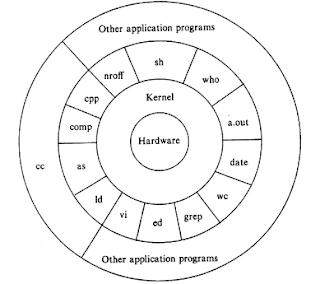SYSTEM STRUCTURE
The structure of UNIX system is a set of well defined layers, each performing different functions according to their levels.
The hardware provides the operating system with basic services. The operating system directly interacts with the hardware, providing common services to programs.
Kernel
The kernel is a set of system programs which build up the operating system. The kernel acts as a mediator between user programs and hardware.
Viewing the system as a set of layers, the operating system is commonly called the system kernel, emphasising its implementations of the UNIX system, the operating system interacts with a native operating system that, in turn, interacts with the underlying hardware and provides necessary services to the system.
Unix Programs
Programs such as the shell and editors (ed and vi) shown in the outer layers interact with the kernel by invoking a well defined set of system calls. The system calls instruct the kernel to do various operations for the calling program and exchange data between the kernel and the program.
Several programs shown in the figure are in standard system configurations and are known as commands, but private user programs may also exist in this layer as indicated by the program whose name is a.out, the standard name for executable files produced by the C compiler.
Other Application Programs
Other application programs can build on top of lower-level programs, hence the existence of the outermost layer in the figure.
For example, the standard C compiler, cc, is in the outermost layer of the figure: it invokes a C pre-processor, two-pass compiler, assembler, and loader (link-editor), all separate lower programs.
Friends, if you find this post useful please comment below. If you want quick notes for any topic please mail us at hardikpanchal551@gmail.com, we will try to provide notes if possible. Thanks for reading.




No comments:
Post a Comment